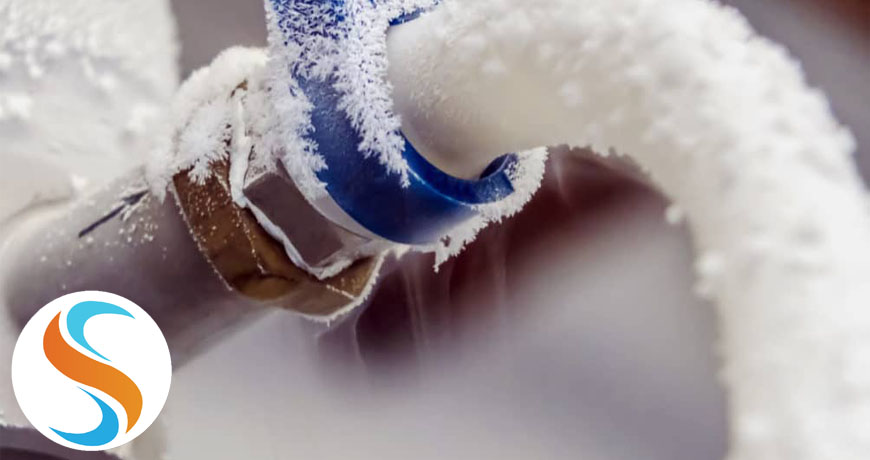Welcome to our informative blog post on essential tips for preventing frozen pipes in winter and avoiding costly plumbing issues. As the temperature drops, the risk of frozen pipes becomes a significant concern for homeowners. When water freezes inside your pipes, it can cause them to burst, leading to extensive damage and expensive repairs.
In this article, Sentral HVAC will provide you with practical strategies and preventive measures that you can implement to safeguard your home’s plumbing system during the winter months. By following these tips, you can minimize the chances of experiencing frozen pipes and mitigate potential headaches down the line.
By proactively implementing these preventative measures outlined in “Essential Tips: How to Prevent Frozen Pipes in winter and Avoid Costly Plumbing Issues,” you can ensure a smooth-running plumbing system throughout the colder months while protecting your home from potential water damage and costly repairs. Let’s dive into these invaluable insights together!
Essential Tips and Preventive Measures
During the winter months, it is crucial to take proactive steps to safeguard your home’s plumbing system from freezing pipes and potential damage. Here are some essential tips and preventive measures you can implement:
- Insulate Exposed Pipes: Identify any exposed pipes in unheated areas such as basements, crawl spaces, or attics. Insulate them using pipe insulation sleeves or wrapping them with heat tape. This helps retain heat and prevent freezing.
- Seal Air Leaks: Locate any gaps or cracks near pipes that allow cold air to seep in. Use caulk or weather-stripping to seal these openings, preventing cold drafts from reaching the pipes.
- Maintain Adequate Heating: Keep your home adequately heated during colder periods, especially at night when temperatures tend to drop further. Set the thermostat above 55°F (12°C) even if you’re away to ensure a warm enough environment for the pipes.
- Open Cabinet Doors: In kitchens and bathrooms where plumbing runs through cabinets, leave cabinet doors open to allow warm air circulation around the pipes.
- Drip Faucets: During extremely low temperatures, consider allowing faucets connected to vulnerable pipes (e.g., those on exterior walls) to drip slightly overnight. The movement of water can help prevent freezing.
- Disconnect Outdoor Hoses: Before winter arrives, disconnect and drain all outdoor hoses properly. Shut off exterior water valves if present and ensure proper drainage of residual water from outdoor faucets/spigots.
- Protect Outdoor Faucets/Spigots: Install insulated faucet covers over outdoor spigots or wrap them with towels/cloths secured by duct tape for added protection against freezing temperatures.
Proper Insulation Techniques: Protecting Exposed Pipes from Freezing
Proper insulation techniques for exposed pipes are crucial in preventing them from freezing during the winter months. By insulating these vulnerable pipes, you can retain heat and protect them from extreme temperatures. Here are some key tips to ensure effective insulation:
- Pipe Insulation Sleeves: Utilize pipe insulation sleeves made of foam or fiberglass to wrap around exposed pipes. This creates a protective barrier against cold air and helps maintain a consistent temperature.
- Heat Tape: Consider using heat tape, also known as heating cable or trace heating, for added protection. It is an electrical device that wraps around the pipe and provides controlled heat to prevent freezing.
- Seal Gaps and Cracks: Before applying insulation, make sure to seal any gaps or cracks near the pipes using caulk or weather-stripping materials. This prevents cold drafts from reaching the pipes.
- Pay Attention to Unheated Areas: Be particularly vigilant with insulating exposed pipes in unheated areas such as basements, crawl spaces, attics, garages, and exterior walls.
Steps to Take When Temperatures Plummet
When temperatures plummet during winter, it’s crucial to take specific steps to protect your plumbing system. Here are some important measures to consider:
- Keep Interior Doors Open: To maintain a consistent flow of warm air throughout your home, ensure that interior doors remain open. This helps in circulating heat and prevents cold spots from forming near vulnerable areas.
- Use Insulation Foam: Insulate any cracks or gaps around windows, doors, and vents using insulation foam or weather-stripping materials. This minimizes the entry of cold air into your home and keeps the temperature stable.
- Apply Pipe Heating Cables: For extra protection against freezing temperatures, consider installing pipe heating cables on exposed pipes located in unheated areas like basements or attics. These cables provide controlled heat and prevent pipes from freezing.
Conclusion
In conclusion, by following these preventive measures, you can enjoy a worry-free winter season while preserving the integrity of your plumbing system for years to come. Taking proactive measures to prevent frozen pipes not only ensures a consistent water supply but also prevents potential damage and expensive repairs associated with burst pipelines. Stay prepared and take action to protect your home from the risks of frozen pipes – it’s an investment that pays off in both peace of mind and cost savings.

